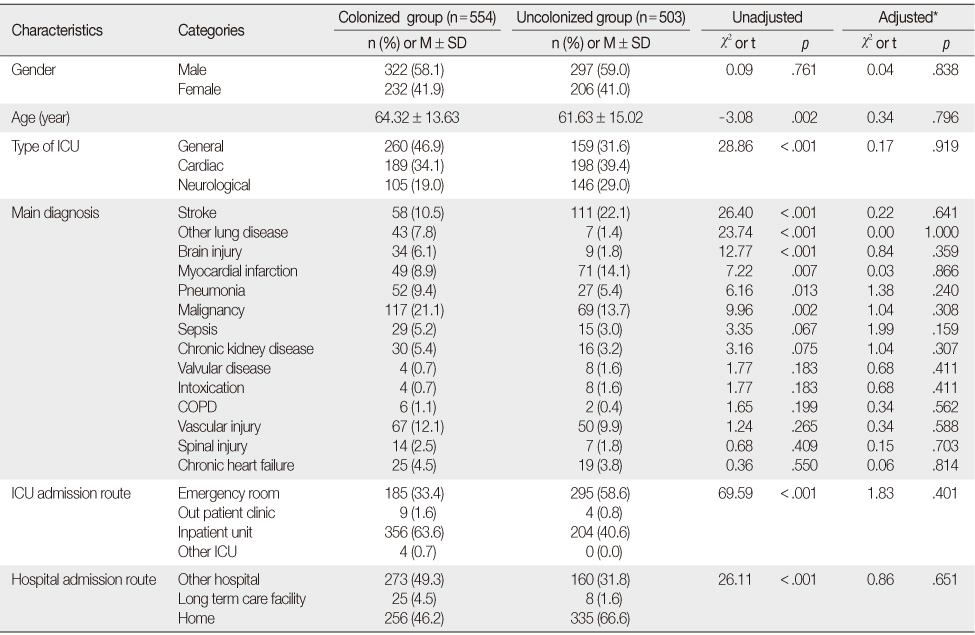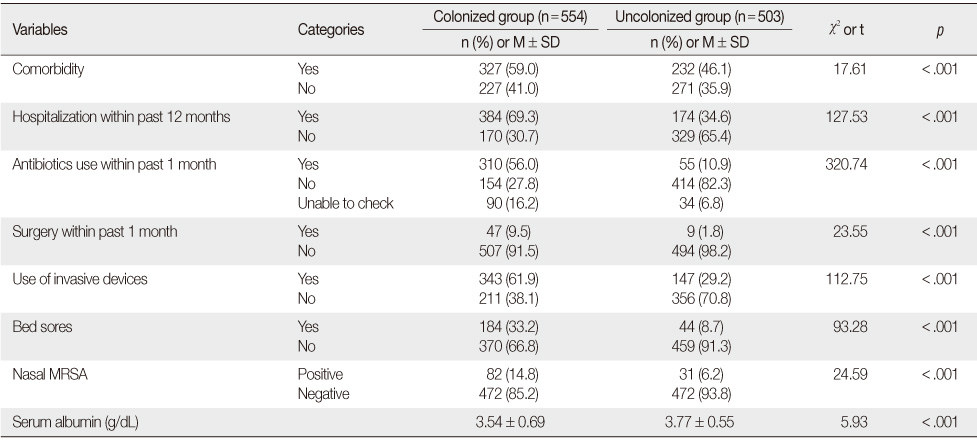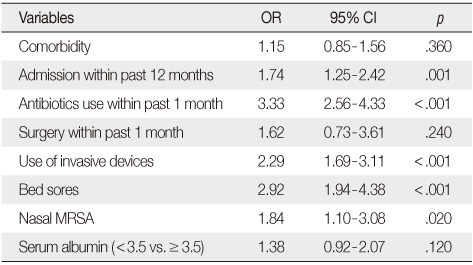Articles
- Page Path
- HOME > J Korean Acad Nurs > Volume 43(2); 2013 > Article
-
Original Article
- Risk Factors and Clinical Outcomes for Vancomycin-Resistant Enterococcus Colonization on Intensive Care Unit Admission
- Sook-Jin Byun, Jiyeon Kang
-
Journal of Korean Academy of Nursing 2013;43(2):287-295.
DOI: https://doi.org/10.4040/jkan.2013.43.2.287
Published online: April 30, 2013
1Infection Control Team, Dong-A University Medical Center, Busan, Korea.
2Department of Nursing, Dong-A University, Busan, Korea.
- Address reprint requests to: Kang, Jiyeon. Department of Nursing, Dong-A University, 1 Dongdaesin-dong, 3-ga, Seo-gu, Busan 602-714, Korea. Tel: +82-51-240-2871, Fax: +82-51-240-2920, jykang@dau.ac.kr
© 2013 Korean Society of Nursing Science
Abstract
-
Purpose
- The purpose of this study was to identify vancomycin-resistant enterococcus (VRE) colonization rate in patients admitted to the intensive care unit (ICU), associated risk factors and clinical outcomes for VRE colonization.
-
Methods
- Of the 7,703 patients admitted to the ICUs between January, 2008 and December, 2010, medical records of 554 VRE colonized and 503 uncolonized patients were reviewed retrospectively. To analyzed the impact of colonization on patients' clinical outcomes, 199 VRE colonized patients were matched with 199 uncolonized patients using a propensity score matching method.
-
Results
- During the study period, 567 (7.2%) of the 7,703 patients were colonized with VRE. Multivariate analysis identified the following independent risk factors for VRE colonization: use of antibiotics (odds ratio [OR]=3.33), having bedsores (OR=2.92), having invasive devices (OR=2.29), methicillin-resistant Staphylococcus aureus co-colonization (OR=1.84), and previous hospitalization (OR=1.74). VRE colonized patients were more likely to have infectious diseases than uncolonized patients. VRE colonization was associated with prolonged hospitalization and higher mortality.
-
Conclusion
- Strict infection control program including preemptive isolation for high-risk group may be helpful. Further research needs to be done to investigate the effects of active surveillance program on the incidence of colonization or infection with VRE in the ICU.
- 1. Choi KO, Kim NC. Effects of infection control strategies for vancomycin resistant enterococci in intensive care units. J Korean Acad Adult Nurs. 2009;21(4):435–445.
- 2. Denkinger CM, Grant AD, Denkinger M, Gautam S, D'Agata EM. Increased multi-drug resistance among the elderly on admission to the hospital-A 12-year surveillance study. Arch Gerontol Geriatr. 2013;56(1):227–230. http://dx.doi.org/10.1016/j.archger. 2012.05.006.ArticlePubMed
- 3. Efe Iris NE, Sayiner H, Yildirmak T, Simsek F, Arat ME. Vancomycin-resistant Enterococcus carrier status in the reanimation units and related risk factors. Am J Infect Control. 2013;41(3):261–262. http://dx.doi.org/10.1016/j.ajic.2012.04.331.ArticlePubMed
- 4. Han SH, Park HR. Risk factors for colonization and acquisition with vancomycin-resistant enterococci in intensive care units. J Korean Acad Fundam Nurs. 2008;15(4):522–530.
- 5. Hayden MK, Blom DW, Lyle EA, Moore CG, Weinstein RA. Risk of hand or glove contamination after contact with patients colonized with vancomycin-resistant enterococcus or the colonized patients' environment. Infect Control Hosp Epidemiol. 2008;29(2):149–154. http://dx.doi.org/10.1086/524331.ArticlePubMed
- 6. Huskins WC, Huckabee CM, O'Grady NP, Murray P, Kopetskie H, Zimmer L, et al. Intervention to reduce transmission of resistant bacteria in intensive care. N Engl J Med. 2011;364(15):1407–1418. http://dx.doi.org/10.1056/NEJMoa1000373.ArticlePubMedPMC
- 7. Jeong SJ. Impact of vancomycin-resistant enterococci acquisition on the prognosis among patients with cancer. 2008;Seoul, Yonsei University. Unpublished master's thesis.
- 8. Kee SY, Park CW, Lee JE, Kwon YJ, Pyo HJ, Kim WJ, et al. Healthcare-associated risk factors of vancomycin-resistant Enterococci colonization among outpatients undergoing hemodialysis. Jpn J Infect Dis. 2012;65(1):57–60.ArticlePubMed
- 9. Kim DR, Yu CW, Cheong HJ, Woo HJ, Choi SJ, Kim WJ, et al. Rectal surveillance culture of vancomycin-resistant enterococci (VRE) colonization among patients hospitalized in the intensive care unit (ICU). J Korean Soc Chemother. 2001;19(2):87–97.
- 10. Kim HJ, Kang SJ, Park HK, Kim CR, Choi TY, Oh SH. The effect of eradication of methicillin-resistant staphylococcus aureus from neonatal intensive care unit by aggressive infection control measures: isolation program and the use of chlorhexidine. Korean J Perinatol. 2010;21(3):248–257.
- 11. Kim YJ, Kim SI, Kim YR, Lee JY, Park YJ, Kang MW. Risk factors for vancomycin-resistant enterococci infection and mortality in colonized patients on intensive care unit admission. Am J Infect Control. 2012;40(10):1018–1019. http://dx.doi.org/10.1016/j.ajic.2012.01.009.ArticlePubMed
- 12. Korean Society for Nosocomial Infection Control. Infection control and prevention in healthcare facilities. 2011;4th ed. Seoul, Hanmi Medical Publishing Co..
- 13. MacIntyre CR, Empson M, Boardman C, Sindhusake D, Lokan J, Brown GV. Risk factors for colonization with vancomycin-resistant enterococci in a Melbourne hospital. Infect Control Hosp Epidemiol. 2001;22(10):624–629. http://dx.doi.org/10.1086/501833.ArticlePubMed
- 14. Matar MJ, Tarrand J, Raad I, Rolston KV. Colonization and infection with vancomycin-resistant enterococcus among patients with cancer. Am J Infect Control. 2006;34(8):534–536. http://dx.doi.org/10.1016/j.ajic.2006.04.205.ArticlePubMed
- 15. McNeil SA, Malani PN, Chenoweth CE, Fontana RJ, Magee JC, Punch JD, et al. Vancomycin-resistant enterococcal colonization and infection in liver transplant candidates and recipients: Aprospective surveillance study. Clin Infect Dis. 2006;42(2):195–203. http://dx.doi.org/10.1086/498903.ArticlePubMed
- 16. Milstone AM, Song X, Beers C, Berkowitz I, Carroll KC, Perl TM. Unrecognized burden of methicillin resistant staphylococcus aureus and vancomycin resistant enterococcus carriage in the pediatric intensive care unit. Infect Control Hosp Epidemiol. 2008;29(12):1174–1176. http://dx.doi.org/10.1086/592093.ArticlePubMed
- 17. Ministry of Health and Welfare. Guideline for prevention and management of hospital infection. 2005;03;Seoul, Author.
- 18. Olivier CN, Blake RK, Steed LL, Salgado CD. Risk of vancomycin- resistant enterococcus (VRE) bloodstream infection among patients colonized with VRE. Infect Control Hosp Epidemiol. 2008;29(5):404–409. http://dx.doi.org/10.1086/587647.ArticlePubMed
- 19. Pacio GA, Visintainer P, Maguire G, Wormser GP, Raffalli J, Montecalvo MA. Natural history of colonization with vancomycin- resistant enterococci, methicillin-resistant Staphylococcus aureus, and resistant gram-negative bacilli among long-term-care facility residents. Infect Control Hosp Epidemiol. 2003;24(4):246–250. http://dx.doi.org/10.1086/502201.ArticlePubMed
- 20. Pan SC, Wang JT, Chen YC, Chang YY, Chen ML, Chang SC. Incidence of and risk factors for infection or colonization of vancomycin- resistant enterococci in patients in the intensive care unit. PLoS One. 2012;7(10):e47297. http://dx.doi.org/10.1371/journal.pone.0047297.ArticlePubMedPMC
- 21. Park YJ, Jeong JS, Park ES, Shin ES, Kim SH, Lee YS. Survey on the infection control of multidrug-resistant microorganisms in general hospitals in Korea. Korean J Nosocomial Infect Control. 2007;12(2):112–121.
- 22. Perencevich EN, Fisman DN, Lipsitch M, Harris AD, Morris JG Jr, Smith DL. Projected benefits of active surveillance for vancomycin- resistant enterococci in intensive care units. Clin Infect Dis. 2004;38(8):1108–1115. http://dx.doi.org/10.1086/382886.ArticlePubMed
- 23. Siegel JD, Rhinehart E, Jackson M, Chiarello L. Management of multidurg-resistant organisms in healthcare settings, 2006. 2006;Retrieved April 2, 2012. from http://www.cdc.gov/hicpac/pdf/guidelines/MDROGuideline2006.pdf.
- 24. Snyder GM, O'Fallon E, D'Agata EM. Co-colonization with multiple different species of multidrug-resistant gram-negative bacteria. Am J Infect Control. 2011;39(6):506–510. http://dx.doi.org/10.1016/j.ajic.2010.09.012.ArticlePubMedPMC
- 25. Song JY, Cheong HJ, Jo YM, Choi WS, Noh JY, Heo JY, et al. Vancomycin-resistant enterococcus colonization before admission to the intensive care unit; A clinico-epidemiologic analysis. Am J Infect Control. 2009;37(9):734–740. http://dx.doi.org/10.1016/j.ajic.2008.09.025.ArticlePubMed
- 26. The Steering Committee of the Korean Nosocomial Infections Surveillance System. Korean nosocomial infections surveillance system (KONIS) report: Data summary from July 2011 through June 2012. 2012;Retrieved December 10, 2012. Available from: http://konis.cdc.go.kr/konis/sub/reports_icu.htm.
- 27. Weber SG, Huang SS, Oriola S, Huskins WC, Noskin GA, Harriman K, et al. Legislative mandates for use of active surveillance cultures to screen for methicillin resistant staphylococcus aureus and vancomycin-resistant enterococci: Position statement from the joint SHEA and APIC task force. Infect Control Hosp Epidemiol. 2007;28(3):249–260. http://dx.doi.org/10.1086/512261.ArticlePubMed
- 28. Zhou Q, Moore C, Eden S, Tong A, McGeer A. Factors associated with acquisition of vancomycin-resistant enterococci (VRE) in roommate contacts of patients colonized or infected with VRE in a tertiary care hospital. Infect Control Hosp Epidemiol. 2008;29(5):398–403. http://dx.doi.org/10.1086/587187.ArticlePubMed
REFERENCES
Figure & Data
REFERENCES
Citations

- Vancomycin Resistant Enterococci Prevalence, Antibiotic Susceptibility Patterns and Colonization Risk Factors Among HIV-Positive Patients in Health-Care Facilities in Debre Berhan Town, Ethiopia
Mikiyas Zike, Abdurahaman Ahmed, Awraris Hailu, Bedru Hussien
Infection and Drug Resistance.2024; Volume 17: 17. CrossRef - Previous antibiotic therapy as independent risk factor for the presence of vancomycin-resistant enterococci in surgical inpatients. Results from a matched case-control study
Philip MacKenzie, Jacqueline Färber, Marius Post, Torben Esser, Lukas Bechmann, Siegfried Kropf, Roland Croner, Gernot Geginat
BMC Infectious Diseases.2023;[Epub] CrossRef - Steady Inflow of Vancomycin-Resistant Enterococci from Outside a Hospital
Hye-sun An, Sang-Won Park, Su-hui Ko, Ji Hwan Bang
Korean Journal of Healthcare-Associated Infection Control and Prevention.2017; 22(2): 63. CrossRef - Vancomycin-resistant Enterococcus colonization in the intensive care unit: Clinical outcomes and attributable costs of hospitalization
Euihan Jung, Sookjin Byun, Hojin Lee, Sang Yi Moon, Hyuck Lee
American Journal of Infection Control.2014; 42(10): 1062. CrossRef
Characteristics of Study Patients
ICU=Intensive care unit; COPD=Chronic obstructive pulmonary disease.
*After propensity score matching (N =398)
Factors Influencing VRE Colonization
MRSA=Methicillin resistant staphylococcus aureus.
Multivariate Analysis of Risk Factors for VRE Colonization
OR=Odds ratio; 95% CI=5% confidence interval to OR; MRSA=Methicillin resistant staphylococcus aureus.
Comparison of Clinical Outcomes between VRE Colonized and Uncolonized Groups
*Multiple checks allowed; ICU=Intensive care unit.
ICU=Intensive care unit; COPD=Chronic obstructive pulmonary disease. *After propensity score matching (
MRSA=Methicillin resistant staphylococcus aureus.
OR=Odds ratio; 95% CI=5% confidence interval to OR; MRSA=Methicillin resistant staphylococcus aureus.
*Multiple checks allowed; ICU=Intensive care unit.
 KSNS
KSNS
 E-SUBMISSION
E-SUBMISSION




 Cite
Cite

